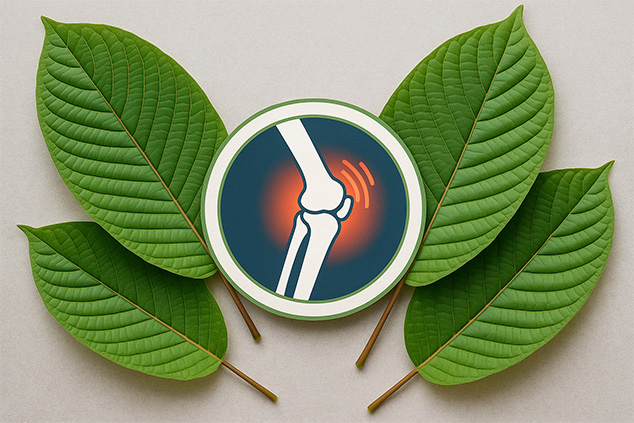Arthritis is a growing concern among the adult population of America. According to the CDC, there are over 54 million people in the United States with arthritis. This equates to roughly 23% or one in every four people.
While arthritis is more common among adults over 65, yet people at any age, even children and teenagers can develop early arthritis symptoms.
Around 60% of the affected with arthritis are people of working age (18-64). Arthritis can limit what tasks they can perform, and well as making working impossible. In fact, arthritis is one of the leading causes of work disability, and the medical costs associated with it are at least $140 billion yearly.
Due to high costs and other issues associated with typical prescription medications, many people seek alternative means of managing their pain. One of them is kratom.
Let’s look more into arthritis and how kratom can help.
What is Arthritis?
Arthritis is an inflammation that affects the joints. Arthritis isn’t a single condition, but rather an umbrella term for over 100 different types of arthritis. Each of them has different symptoms as well as treatment methods.
Some of the most common types of arthritis are:
Osteoarthritis and rheumatoid arthritis are the most frequent ones, yet many describe gout being the most painful one.
Arthritis is a degenerative disease and increases in intensity with time. It can affect different types of joints as well as organs.
The Symptoms of Arthritis
People affected by arthritis most commonly experience pain, swelling, or stiffness around the joints. However, they can also experience a decreased range of motion in the affected joints, especially in the morning, and as their condition worsens with time.
Rheumatoid arthritis is an autoimmune disease, and the immune system of the body mistakenly attacks the joints, other organs, and tissue. As a result, a person with this condition may experience low-grade fever, extreme fatigue, or become anemic.
The Causes of Arthritis
The causes of arthritis depend on the type. Osteoarthritis, the most common form of the condition, as well as some other types are frequently caused by regular wear and tear.
Our joints have cartilage, a firm and flexible type of connective tissue that absorbs the pressure and shock created when we move or put pressure on our joints. As the amount of this cartilage reduces, this is how some forms of arthritis develop.
Rheumatoid arthritis, however, is an autoimmune disease. It is unclear what exactly causes it. However, it makes the immune system attack a type of tissue that produces a fluid that nourished cartilage and helps it work properly. As a result, this condition destroys the bones and cartilage of the joints.
How Is Arthritis Treated?
There is no way of reversing arthritis. Therefore, treatment methods focus on reducing pain and preventing and minimizing additional future damage.
Some of the most common treatments methods include:
- Medication – analgesics, anti-inflammatory drugs, topical creams that clock pain signal transmissions to your joints, or immunosuppressants,
- Surgery – in severe cases, an affected joint may be replaced with a new and artificial one. Knee and hip replacement surgeries are some of the common ones. In severe cases of wrist and finger arthritis, doctors may recommend joint fusion surgery during which they link joints together, which eventually causes them to grow together. This reduces pain, yet drastically limits the range of motion.
- Physical therapy – this helps strengthen the muscles surrounding the affected joint and make movement more controlled and easier. Some specialists may also recommend yoga, swimming, and other forms of mild exercise for similar reasons.
- Lifestyle changes – weight reduction and non-inflammatory diet can help reduce and inflammation and manage pain. It is often advised to avoid processed, fried, or dairy products and consume larger amounts of antioxidant-rich and anti-inflammatory foods such as fruits, vegetables, fatty fish, and nuts.
In many cases, doctors advise a combination of two or more methods for a more holistic approach to arthritis management.

Can Kratom for Arthritis Help?
Out of every four people who suffer from arthritis, one experiences severe joint pain. While pain medication and topical solutions are among the most common treatment methods, regular use is not only expensive but can also develop an addiction. As we already know, the opioid crisis is raving, and more than 130 people overdose opioids every single day.
Moreover, arthritis doctors are not available to everyone, especially in rural areas. Only 7% of all arthritis doctors attend patients in rural areas where 20% of the population live.
Therefore, many people seek alternative natural treatment and pain management methods.
Kratom is one of them, and the popularity of this beneficial herb speaks for itself.
According to the American Kratom Association, there are at least 5 million active kratom users in the United States, and their number keeps growing as more people are finding out about its beneficial effects.
How Does Kratom for Arthritis Work?
Kratom alkaloids affect the same receptors in the brain that opioids do. However, in contract with opioids, they do not engage with receptors in quite the same way.
As a result, you can feel pain relief that is akin to what you can experience from opioids, yet without the risk or respiratory depression or addiction associated with opioids.
Moreover, kratom has a wide range of beneficial properties, with potent pain relief being only one of the main reasons for its popularity. The alkaloids in kratom have pain-relieving properties, with 7-hydroxymitragynine being about 13 times more potent than morphine.
Moreover, kratom can help with other issues such as depression, anxiety, energy, mood, and focus, which also frequently affect arthritis patients — all that with a single herb.
While many kratom buyers complain about the high kratom costs of some vendors, it can still be a lower investment than buying all the different types of medication that doctors may prescribe or recommend.
Kratom community agrees, with people even indicating that kratom for arthritis and joint pain is “god-sent.”
Best Strains of Kratom for Arthritis
Depending on what type of arthritis affects you and your other needs, you may benefit from looking into different strains of kratom for different times of the day, as well as unique effects that you may be looking for. While various strains of kratom for arthritis can be effective, different kratom veins and stems also have their unique effects and benefits.
Let’s take a look at which the best strains of kratom for arthritis are.
1. Red Bali Kratom
Reds, in general, provide the most potent kratom pain relief for arthritis. However, you may find Red Bali Kratom to be one of the best choices for potent arthritis pain relief.
Red Bali is a popular, widely available, and affordable strain that provides relaxation and strong pain relief. It also boosts the mood and makes you feel euphoric.
However, Red Bali is a sedating strain, making it an excellent strain of kratom for arthritis relief in the evening and at night. It can help you relax, wind down, fall, and stay asleep, as well as have a better rest.
You can also look into other red strains such as Red Thai, Red Borneo, and Red Horn for similar effects.
2. Green Maeng Da Kratom
Another popular strain, Green Maeng Da provides milder pain relief, but it is also energizing. Therefore, you can feel more positive and energetic and get through your daily-to-do list easier and with less pain.
Green Maeng Da also can improve the mood and help with depression symptoms. Many find Green Maeng Da kratom effective for anxiety as it calms down intrusive thoughts and helps you a calm and steady focus.
You can also try Green Malay or Plantation Maeng Da Kratom for arthritis pain relief and other similar effects.
3. White Borneo
White Borneo Kratom is a fast strain. This means that its most potent effects are increased focus, better mood, and ore energy.
White Borneo won’t be the most potent strain of kratom for arthritis; yet, if you suffer from mood disorders, low energy, and motivation and require a bit of extra help to manage your arthritis pain throughout the day, then White Borneo may be a great strain for you.
Check out White Thai, White Bali, and White Horn Kratom for similar effects.
Last but not least, make sure to dose each strain properly and according to the recommended amounts. Fast, moderate, and slow strains all require different dosages, and taking too much kratom can result in you feeling nauseous and sick.
Do you suffer from arthritis? Which type affects you? Have you tried kratom for arthritis, and how did it make you feel? Which strains do you prefer? Feel free to share your experience and tips with us and the Speciosa Guide community.



Leave a Reply